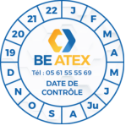
Assisted ventilation in ATEX zones
The important thing is to breathe!
We breathe in 25,000 times a day to renew the air contained in our lungs through the action of the respiratory muscles, the main one being the diaphragm: This is breathing, also called pulmonary ventilation. Our lungs are important and it is important to know how to protect them.
> See our article How to choose your respiratory protection ?
In this article, we will focus on assisted ventilation devices, especially in explosive areas. They are designed to protect the user in hazardous atmospheres while providing comfort and ease of use.
What is an assisted ventilation device?

In respiratory protection, there are two main families: filtering respiratory protection and insulating respiratory protection.
Assisted ventilation devices are part of the filtering protection known as positive pressure. They are generally used when working conditions are difficult and are composed of
- A filter (particle, anti-gas or combined)
- A flexible hose
- A face piece (cap or mask)
- A motor (ventilation unit).
This type of ventilation is very comfortable for the wearer because the motor filters the air from the surrounding atmosphere of pollutants such as dust, gas or vapors. The filtered air arrives in abundance in the cap or mask without mechanical effort. They protect the respiratory tract, head, face, eyes and ears. They are modular systems focused on comfort and ease of use.
> When to use an assisted ventilation device ?
For the use of a ventilation device, the oxygen content must be normal (at least 17%) and the concentration must be between 30 and 60x TLV or above 60x TLV for long interventions. More concretely, the concentrations of the hazardous substances must be within the permitted limits or they must not represent an immediate danger of death or loss of consciousness.
> When to run away ?
Caution should be exercised when using assisted ventilation, even if it is validated by the risk assessment. It is important to know that the breakdown time of a filter varies according to the substances present, the user (and more particularly his air consumption), the environment (humidity and air temperature). Breakdown occurs when the user perceives a taste, an odor or an increase in resistance when breathing through the filtering protection. At this point, there is still protection but the filter must be changed. On the other hand, the user should leave the area immediately if he/she experiences irritation, dizziness or pain.
> When not to use assisted ventilation ?
- Oxygen content below 17%.
- Hazardous substances that are difficult to detect or that are not blocked by the filter.
- Concentrations of substances that are an immediate danger to life and/or health.

Standards for powered ventilation devices

There are 2 standards for powered air purifying respirators depending on the shape of the respirator. To recognize them, the notations vary according to the type of apparatus for an easy recognition.
> EN 12941 - Powered air purifying respirators with hood or helmet
The shape of this assisted ventilation device is either a hood or a helmet. This version offers multiple advantages: less perspiration, less overlapping of PPE (helmets, glasses, earplugs, ...) and more waterproofness, especially for those who like to wear a three-day beard.
The TH (Turbo Hood) classes determine the level of waterproofness of the complete device. The higher the class, the better the seal.
- TH1 stops 90% of aerosols (i.e. 10% penetration)
- TH2 stops 98% of aerosols (i.e. 2% penetration)
- TH1 stops 99.8% of aerosols (i.e. 0.2% penetration)
> EN 12942 - Powered air-purifying respirators with full facepiece, half facepiece or quarter facepiece
In this case, the device is a half mask, a quarter mask or a full mask.
The TM (Turbo Mask) classes are also used to determine the seal level of the complete device. The higher the class, the better the seal.
- TM1 stops 95% of aerosols (i.e. 5% penetration)
- TM2 stops 99.5% of aerosols (i.e. 0.5% penetration)
- THM stops 99.95% of aerosols (i.e. 0.05% penetration)
> ATEX classification of the X-plore 8700
II 2G Ex ib IIB T4 Gb :
II 2D Ex ib IIIB T135 °C Db
TA: -10 °C < Ta < +50 °C
BE ATEX has tested the X-plore 8700, the assisted ventilation in ATEX environment

The X-plore 8000 range has many advantages:
- Simple: "Plug and Go", just turn it on and wait for the green light to start working
- Modular: many accessories are available
- Intuitive: the RFID chip detects the accessories and automatically adapts the minimum volumetric flow to the connected facepiece
Dräger's expertise has enabled the development of an intrinsically safe assisted ventilation device without any performance limitations despite the ATEX protection. This new equipment offers the same comfort, performance and ease of use as the standard version (X-plore 8500).
The 6 key points of this ATEX protection:
> A patented system of rapid disconnection of electrical overcurrents from the batteries
During a long intervention, it is necessary to change the batteries that power the motor. In ATEX zones, this battery change can be dangerous. Indeed, if the battery is removed, a spark can occur at the contacts and produce an ignition of the atmosphere.
X-plore 8700 has a patented electrical over-current disconnect (patent DE102012013656B4) that lasts a few seconds. The wearer can safely change the battery without any special tools in order to continue his work.
> Electronic temperature monitoring on the printed circuit board (PCB)
It measures the temperature and reduces the power consumption of the motor electronics if necessary.
The surface temperature of X-plore 8700 (in operation) does not exceed the acceptable Ex limits.
> Ex-certified materials to prevent electrostatic charging
The housing material meets the Ex requirements, which prevents electrostatic charges such as rubbing with cotton, for example.
X-plore 8700 is convenient and easy to use: No need to use a special cover or to cover the device with additional paint that can flake off over time.
> Sealing and isolation of high voltage components
In the event of an operating error, sparks may occur but within the seal. That is why the critical components of the X-plore 8700 are specially encapsulated so that they cannot come into contact with a potentially explosive atmosphere.
To date, it is the only ventilation-assisted device that has an acoustic and vibrating alarm!
> Redundant electrical safety circuits
All intrinsically safe circuits are redundant. Thus, if an electrical circuit fails, explosion protection is not impaired.
The X-plore 8700 has 3 times more electronic components than the standard version.
> Almost all the components of the assisted ventilation are ATEX
Special measures were taken during the design phase to ensure that the non-electronic components meet ATEX requirements (to avoid electrostatic charging).
Our conclusion: With the new X-plore 8700, Dräger maintains the high level of performance, handling and safety already conveyed by the X-plore 8500 and also provides reliable ATEX protection for demanding applications.





